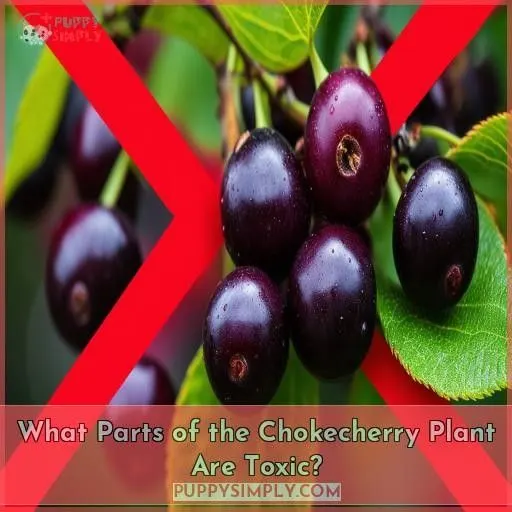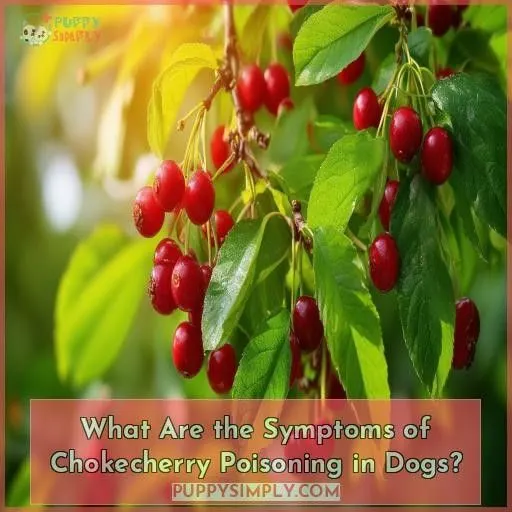This site is supported by our readers. We may earn a commission, at no cost to you, if you purchase through links.
 You should never let your dog eat chokecherries or any part of the chokecherry plant.
You should never let your dog eat chokecherries or any part of the chokecherry plant.
These cherries contain cyanogenic glycosides that release cyanide when ingested, interfering with cellular respiration. Even a small amount can cause dilated pupils, breathing difficulties, bright red gums, shock, and potentially death.
If your dog accidentally consumes chokecherries, induce vomiting, give activated charcoal, and seek immediate veterinary care.
Preventing access by keeping chokecherry plants out of reach is essential for pet safety.
For a more in-depth examination into protecting your furry friend, read on.
Table Of Contents
- Key Takeaways
- Can Dogs Eat Chokecherries?
- What Parts of the Chokecherry Plant Are Toxic?
- How Do Chokecherries Cause Poisoning in Dogs?
- What Are the Symptoms of Chokecherry Poisoning in Dogs?
- How Can Chokecherry Poisoning Be Treated?
- How Can Chokecherry Poisoning Be Prevented?
- Frequently Asked Questions (FAQs)
- What happens if a dog eats a chokecherry?
- Are chokeberries poisonous to dogs?
- Can animals eat chokecherries?
- Can dogs eat chokecherry jam?
- Are chokecherries beneficial for dogs in any way?
- How can chokecherries impact a dogs behavior?
- Are there any dog breeds more susceptible to chokecherry poisoning?
- Can chokecherry toxicity be passed to puppies through their mother?
- What should I do if my dog eats chokecherries while hiking?
- Conclusion
Key Takeaways
- Hell no! Those chokecherries might seem tempting to your pup, but they’re like a cyanide cherry bomb waiting to go off. One nibble and Fido could be gasping for air and seeing stars.
- If your furry friend does manage to sneak a few, don’t wait around – it’s time for an emergency vet visit ASAP. Those cyanide compounds aren’t playing nice with their insides.
- Prevention is key, folks. Keep those chokecherry plants far, far away from your dog’s grazing grounds. A little barrier here, a fence there – anything to create a cherry-free safe zone.
- At the end of the day, chokecherries offer zero benefits for our canine pals. They’re all risk, no reward. So let’s stick to the dog-approved treats and keep those toxic cherries out of paw’s reach.
Can Dogs Eat Chokecherries?
No, dogs shouldn’t eat chokecherries. Chokecherries contain cyanogenic glycosides in all parts of the plant except the ripe fruit, which can cause cyanide poisoning in dogs if ingested in toxic amounts, leading to symptoms like dilated pupils, difficulty breathing, bright red gums, shock, and potentially death (Source).
What Parts of the Chokecherry Plant Are Toxic?
When it comes to chokecherries, it’s key to remember that all parts of the plant, except the ripe pulp around the seeds, are considered toxic to dogs.
The stems, leaves, and seeds contain cyanogenic glycosides, which release cyanide when ingested. This potent toxin can have serious health consequences for your furry friend.
To keep your pup safe, avoid planting chokecherry trees in areas dogs can access and always supervise them when outdoors.
If you suspect your dog has eaten any part of the plant, contact your veterinarian immediately. Early intervention is key to preventing severe complications from chokecherry poisoning.
How Do Chokecherries Cause Poisoning in Dogs?
Now that you know which parts of the chokecherry plant are toxic to dogs, it’s important to understand how these cherries can cause poisoning. Chokecherries contain cyanogenic glycosides, which release cyanide when digested. This potent toxin interferes with cellular respiration, leading to:
- Cyanide absorption through the gastrointestinal tract
- Disruption of aerobic metabolism
- Histotoxic anoxia, or lack of oxygen to tissues
- Damage to the heart and brain due to oxygen deprivation
Cyanide poisoning from chokecherries, peach pits, apple seeds, and cherry seeds can be fatal if not treated promptly. Keep a close eye on your pup and contact your vet immediately if you suspect they’ve eaten a large quantity of these toxic treats.
What Are the Symptoms of Chokecherry Poisoning in Dogs?
If your dog ingests parts of the chokecherry plant, watch for symptoms like dilated pupils, difficulty breathing, bright red gums, shock, and even death. Chokecherries contain cyanogenic glycosides that release cyanide, inhibiting oxygen transport in your dog’s body.
Dilated Pupils
If your dog has ingested chokecherries, watch for dilated pupils.
This is a sign that the cyanide toxicity is affecting their body’s ability to transport oxygen.
Dilated pupils occur because the cyanide is interfering with cellular respiration, depriving tissues like the brain of oxygen.
Seek immediate veterinary care if you notice this symptom after your dog eats black cherries or chokecherries.
Difficulty Breathing
Difficulty breathing in dogs can signal cyanide poisoning after ingesting chokecherries. You’ll notice your dog gasping or struggling for air, which happens due to oxygen deprivation. This severe symptom often comes with vomiting and abdominal pain, indicating serious health consequences. Act fast, as the toxin impacts their ability to breathe, leading to rapid deterioration (Source).
Bright Red Gums
Bright red gums can indicate cyanide toxicity in your dog. Symptoms arise from oxygen deprivation and tissue damage. Potential signs include:
- Cardiovascular effects such as abnormal heart rate.
- Neurological damage leading to seizures or tremors.
- Oxygen deprivation causing respiratory distress.
- Tissue damage manifested in red mucus membranes (Source).
Shock
If your dog is experiencing shock from chokecherry poisoning, their gums will appear bright red. Shock occurs due to cyanide’s effects on oxygen transport, depriving tissues of oxygen. Seek immediate veterinary care, as shock can rapidly progress to organ failure and death without treatment. Provide supportive care if possible, but don’t delay professional help.
Death
If your dog has ingested a large quantity of chokecherry pits, cyanide toxicity can lead to death.
Small dogs are at higher risk due to their size.
Symptoms include dilated pupils, difficulty breathing, bright red gums, and shock.
Seek immediate veterinary care if you suspect pit ingestion.
Keeping chokecherries away from dogs is the best prevention for this potentially fatal condition.
How Can Chokecherry Poisoning Be Treated?
If your dog has ingested chokecherries, it’s critical to act fast. Cyanide toxicity can be life-threatening, so seek emergency veterinary care immediately. The vet may induce vomiting to remove any remaining toxins from your dog’s stomach. They may also administer activated charcoal to absorb the cyanide and IV fluids to support your pup’s essential functions.
- Amyl nitrite and sodium nitrate are effective antidotes that help break the cyanide-cytochrome c oxidase bond and restore oxygen transport.
- Sodium thiosulfate aids in detoxifying cyanide by converting it to a less harmful form that can be excreted.
- Oxygen therapy helps counteract the effects of cyanide poisoning on your dog’s cells.
- Supportive care, such as monitoring vital signs and managing symptoms, is essential for recovery.
With prompt emergency treatment and supportive care, many dogs can recover from chokecherry poisoning. However, prevention is key to keeping your furry friend safe.
How Can Chokecherry Poisoning Be Prevented?
Now that you understand the dangers of chokecherry poisoning in dogs, it’s imperative to learn how to prevent it. The best way to keep your furry friend safe is by keeping chokecherry trees and shrubs out of reach. If you have these plants in your yard, consider relocating them or erecting barriers to prevent access. Regularly inspect your property for fallen cherries and promptly remove them. Educate your family and friends about the potential risks, and always supervise your dog when outdoors. Remember, early treatment is key if ingestion occurs. Consult with your veterinarian for personalized advice on managing chokecherry toxicity risks. By taking proactive steps, you can help guarantee your dog’s safety and well-being.
- Keep chokecherry trees and shrubs out of reach
- Erect barriers to prevent access to plants
- Regularly inspect for and remove fallen cherries
- Educate others about potential risks
- Consult your veterinarian for personalized advice
Frequently Asked Questions (FAQs)
What happens if a dog eats a chokecherry?
Like a dog chasing its tail, eating chokecherries can lead to a vicious cycle. If consumed, your pup may experience vomiting, seizures, and fatal oxygen deprivation due to cyanide poisoning.
Are chokeberries poisonous to dogs?
Yes, chokeberries are poisonous to dogs. They contain cyanide, which blocks oxygen from reaching tissues and can be fatal if consumed in large amounts. Keep your pup away from these plants to avoid potential toxicity.
Can animals eat chokecherries?
No, chokecherries are toxic to most animals due to cyanide compounds in the seeds, leaves, and bark. While birds can safely eat the ripe fruit pulp, it’s best to keep pets away from chokecherry plants to avoid potential poisoning.
Can dogs eat chokecherry jam?
Regarding chokecherry jam, it’s wiser to err on the side of caution – dogs are unable to consume it, as it might contain minute traces of cyanide derived from the cherry pits.
Are chokecherries beneficial for dogs in any way?
Nope, chokecherries offer no real benefits for dogs. They contain cyanide, which is toxic and potentially fatal if ingested in large amounts. It’s best to keep these fruits well away from your furry friend.
How can chokecherries impact a dogs behavior?
Chokecherries can make your pup hyperactive from their natural sugar content. They may also experience upset stomach, vomiting, or diarrhea due to the fruit’s high acidity. Ingesting the pits poses risks of intestinal blockages too. Monitor your dog closely for any concerning symptoms.
Are there any dog breeds more susceptible to chokecherry poisoning?
Is there a link between certain dog breeds and chokecherry poisoning? Let’s investigate: While all dogs are potentially vulnerable, smaller breeds may face higher risks due to their lower body weight and potential to consume proportionally larger amounts. However, responsible pet ownership is key, regardless of breed size.
Can chokecherry toxicity be passed to puppies through their mother?
Yes, chokecherry toxicity can potentially pass to puppies through their mother’s milk. If the mother ingests toxic amounts, it’s important to seek immediate veterinary care for both her and her litter.
What should I do if my dog eats chokecherries while hiking?
Don’t panic, but act quickly if Fido ingests chokecherries on the trail. Rush home, induce vomiting with hydrogen peroxide, and contact your vet immediately to avoid a potentially dire outcome.
Conclusion
Ultimately, the chokecherry plant poses a grave risk to your canine companion. Preventing access by removing these hazardous plants from areas accessible to your dog is essential.
While ingesting chokecherries can have severe consequences, prompt action and veterinary care increase the chances of recovery.









